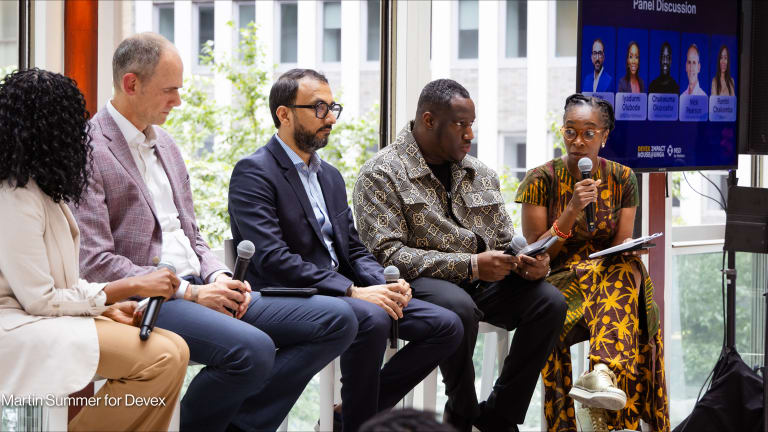
Successful policy advocacy requires clear and impactful communication. Whether rallying public support or engaging policymakers, a strong communication strategy can turn ideas into action. Yet, many advocacy campaigns falter due to misaligned messaging or inadequate strategy, missing critical opportunities to influence decision-makers.
“Advocacy … is that bit of communication which helps the general public and policymakers understand the systemic challenges which are afflicting a particular country,” Onyum Charles Okao, Uganda media coordinator at the Global Health Advocacy Incubator, or GHAI, told Devex.
In public health, where challenges are increasingly complex and resources often limited, the stakes are especially high. Advocates navigate dwindling donor funding, growing competition for attention, and the need to address interconnected health crises — all while crafting messages that resonate and drive change.
So how can public health advocates create campaigns that drive change?
Devex, in partnership with GHAI, explored insights from its newly released eight-step Communications and Media Advocacy Action Guide. Drawing on extensive experience with local partners, the guide offers practical tools and strategies for designing, executing, and monitoring communication campaigns that deliver meaningful results.
Here are four key lessons to help advocates transform ideas into impact.
Start with a clear audience in mind
One of the biggest pitfalls in advocacy is failing to define and prioritize target audiences. GHAI’s guide recommends segmenting audiences and identifying both primary and secondary stakeholders early on for a more targeted approach.
Understanding your audience's priorities, challenges, and motivations helps tailor messages. While there are often many influential audiences, the guide recommends segmenting audiences into primary and secondary groups for a more targeted approach. Once groups have been segmented, focus on the primary audience, which are those closest to moving the needle.
After identifying the primary audience, try to understand what they care about. “Then you can craft messages that are adapted to their worldview, specifically tailored to things that resonate with them and can inspire them to take the action that they want,” Okao told Devex.
For example, in Vietnam’s campaign to address child drowning — a leading cause of death for children aged 6-15 — advocates successfully identified decision-makers such as the prime minister and officials at the country’s Ministry of Labour - Invalids and Social Affairs, or MOLISA, which is responsible for child protection, among other duties. By tailoring their messages to these stakeholders, the campaign secured approval for the national program on child drowning prevention (2025-2035).
Create concise, compelling messages
Decision-makers are often inundated with competing narratives. With so much other information competing for their attention, messages need to be clear, consistent and tailored to capture the attention and resonate with the recipient.
Ultimately, the message needs to outline the policy change you seek and why it matters. To this end, key data points can be helpful. “Using the data, we're able to ascertain where the issue is, what the issue is, and who it is affecting,” said Okao.
In the same Vietnamese child drowning campaign, GHAI paired local data from the Hanoi University of Public Health with personal stories of families impacted by drowning, explained Giang Bui, Vietnam program manager at GHAI.
Okao added that pairing data with personal stories is a particularly effective communications strategy. “When we craft the statistics and [package them together with] personal stories, then we're able to humanize the statistics and create an emotional connection.”

Explainer: How can advocates use this guide?
The eight-step Communications and Media Advocacy Action Guide outlines eight essential steps for designing, executing, and monitoring effective communication strategies tailored for policy advocacy. The guide also complements GHAI’s broader Advocacy Action Guide by providing templates, examples, and insights specifically crafted for public health contexts.
Select effective messengers
The right messenger can make or break an advocacy campaign. Advocates should carefully select individuals who resonate with the target audience and lend credibility to the campaign’s goals. “No matter how perfect the message is, if you have the wrong messenger, it can ruin the campaign,” Jennifer Patterson, communications director at GHAI told Devex.
Likewise, the guide suggests combining and presenting diverse voices to broaden the campaign’s reach, such as pairing subject matter experts with someone who has a strong connection to the audience, such as a community leader.
Belinda Moses, associate director of communications for the African region at the Campaign for Tobacco-Free Kids, added that it was important to give a “real, authentic human voice to the policy story” in order to effect changes successfully. “Advocates can present compelling narratives pushing their policy cause. Messages that are delivered clearly in the tone and language that audiences understand will help convince opinion influencers and decision-makers to make changes in a particular policy.”
Use strategic media channels
A well-planned media strategy can amplify advocacy messages and expand their reach.
Okao stressed the need to carefully choose and leverage media platforms that will reach the right audience, for example policymakers. “We work through this medium to identify specific data and patterns. By strategically using messaging to highlight these challenges, policymakers can clearly see how these issues are impacting communities,” said Okao.
The guide recommends media mapping to identify the relevant platforms that an audience trusts so that the message gets through. Likewise, combining traditional and digital platforms can increase message awareness to better reach both policymakers and grassroots supporters, said Patterson.
In Vietnam, for instance, the drowning prevention campaign utilized a combination of traditional TV coverage, community loudspeakers, and a parent-focused Facebook group to engage both policymakers and local communities. This multipronged approach ensured that the campaign’s message reached a broad and diverse audience.
This approach has had a considerable impact. “Since 2018, more than 47,000 children, ages 6-15, have learned to swim, 14 new pools have been constructed and kids and parents are much more aware of the dangers of drowning and how to prevent it,” said Bui.
For more insights and resources, download the eight-step Communications and Media Advocacy Action Guide from the Global Health Advocacy Incubator.




